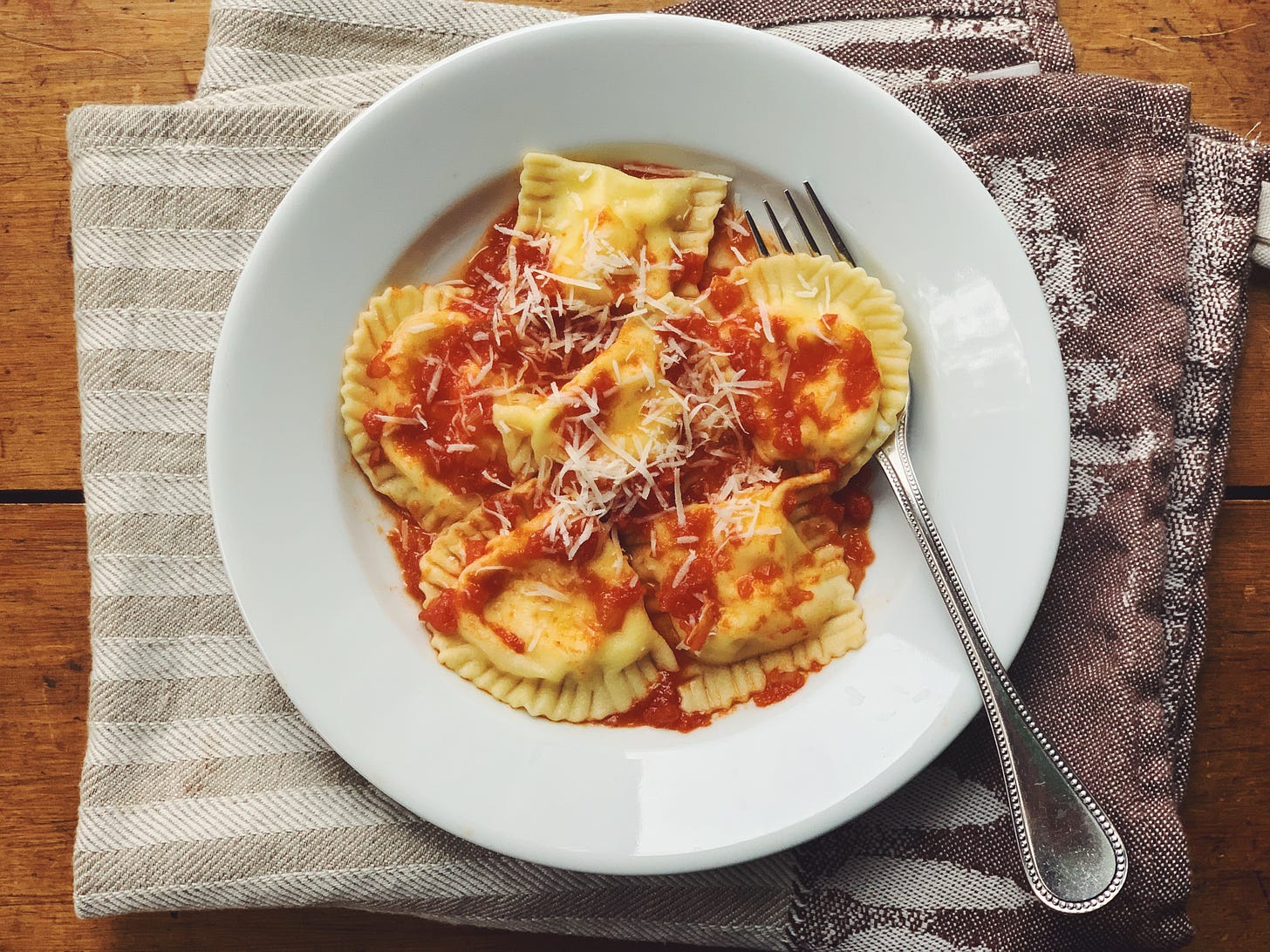Gabriella’s Ricotta Ravioli
A guest post from my friend Domenica Marchetti, food writer, cookbook author, and cooking class teacher: today she is sharing the recipe for her mum's ricotta ravioli from Abruzzo.
Today I’m very happy to share this space with Domenica Marchetti, a food writer, author of many cookbooks, including Preserving Italy1 (one of my favourite and most used preserving books), and now also the author of one of my favourite newsletters here on Substack, Buona Domenica, where she shares recipes, interviews, and inspiration. She also teaches in-person and online cooking classes, and hosts tours and workshops in Italy.
We met online over a decade ago, and immediately connected as we share the same love for traditional regional Italian recipes, comforting home food, and fresh pasta. A couple of years ago (or is it more? you always have to add two more years when you count back to pre-Covid times, so Domenica we have to meet again!) we met for a lunch here at the studio while she was passing through Tuscany, going from Liguria to Abruzzo, and it felt like we were long-standing friends.
So go subscribe to Domenica’s newsletter for delicious, authentic Italian recipes, written with compelling, vivid prose, and a good dose of humour.
And now, to Domenica.
Ciao! Hello to the Juls’ Kitchen community here on Substack. I’m honored to be trading places with Giulia this week. I hope you enjoy this piece I wrote about making my mom’s Abruzzese-style ricotta ravioli.
* * * * * *
Like a magpie, I am hopelessly attracted to bright shiny objects, things that sparkle and gleam. I’m not talking about silver bangles or gold rings (though I love those things, too). In this case, I’m talking about pasta tools.
Over the years, I have amassed quite a collection of fancy tools for cutting and shaping pasta. These include wood- and brass-handled cutting wheels (tagliapasta) fitted with beautiful, lustrous, heavy brass heads. Some have single straight blades, others have fluted blades with sharp teeth for cutting fancy zig-zag edges into pasta. I also have brass and stainless ravioli stamps of different sizes, round and square, which I use to make filled pasta like anolini, agnolotti, ravioli, and tortelli. I have ferri (long brass or iron rods) for making fusilli, and I have polished wooden boards and molds with carvings for making patterned pasta dough.

I love all these tools, and I use them often, but not when I make my mom’s ravioli. For those I need only two tools: a simple fluted stainless steel pastry cutter and a basic table fork, the same tools my mom used.
My mom was from Chieti, a city on a hill in Italy’s Abruzzo region that dates to pre-Roman times. She moved to New York as a young woman, met my dad on a blind date, and stayed. Mom was an adventurous self-taught cook, dabbling in Mexican, Chinese, and other cuisines and even sourdough baking back in the 1970s. But most nights she cooked Italian, using family recipes and Ada Boni’s Talismano della Felicità as her guides. On weekends she made beautiful homemade pasta—without fancy tools. One of my strongest childhood memories is of standing at the counter in our kitchen in New Jersey as Mom rolled out sheets of dough on her hand-crank Atlas pasta machine, mounded on spoonfuls of creamy ricotta filling, and cut out half-moon ravioli with her fluted cutter. It was my sister’s and my job to seal each raviolo shut by pressing the tines of a fork around the edges, a job we took seriously.
There are many types of ravioli and stuffed pasta throughout Italy, from dainty “pinched” agnolotti del plin in Piemonte and Bologna’s tiny tortellini to the intricately sealed culurgiones from Sardegna. When compared to these more elegant ravioli, Abruzzo’s hand-cut version are decidedly more rustic. But that, of course, is part of their appeal. Their rustic character makes them truly satisfying to eat.
The egg dough is made with fine “00” flour, plus a little semolina mixed in, the traditional combination for Abruzzese pasta. While the dough for Abruzzese ravioli should be stretched thin, it shouldn’t be too thin—somewhere between 1/16 and 1/8 inch (about 2 mm). The ravioli cut from this dough are fairly large, and generously filled with fresh sheep’s milk ricotta and grated pecorino cheese, like tender pillows. The filling makes perfect sense, since Abruzzo is a land of pastoral traditions, a place whose identity and economy were for centuries tied to the raising of sheep, and the region still produces some of the best sheep’s milk cheeses in all of Italy.
As for the sauce, my mom always dressed her ravioli with simple tomato sauce or ragù. Both are delicious, but to me the pairing of fresh ricotta-filled ravioli and simple tomato sauce can’t be beat. Enjoy!
Gabriella’s Ricotta Ravioli
A note about making pasta: My mom was an early adopter of the food process method for making pasta. It makes quick work of mixing the dough and it’s a great time saver. However, if you prefer, you can mix the dough by hand on your work surface in the traditional way. I’ve given instructions for both methods below.
Makes 4 servings
For the pasta
280 g (2 cups + 2 tablespoons) “00” flour
2 tablespoons semola rimacinata (semolina flour)
3 extra-large eggsFor the filling 500 g (1 lb) fresh sheep’s milk or cow’s milk ricotta, well drained ½cup (40 to 50 g) freshly grated Pecorino Abruzzese (or Romano) or Parmigiano-Reggiano cheese ¼ teaspoon fine sea salt 1 egg yolk (optional)
To serve Simple Tomato Sauce Freshly grated Pecorino Abruzzese (or Romano) or Parmigiano-Reggiano) for serving
INSTRUCTIONS
1. Make the pasta:
To make the dough by hand: Combine the flour and semolina a clean work surface. Form a mound and create a wide well in the center. Carefully break the eggs into the well and mix with a fork. Slowly begin to incorporate the inner wall of flour as you mix. When the mixture has thickened to a pasty consistency, begin using your fingers to incorporate more flour. Continue to mix until a rough dough has formed. You may not need all the flour; use a dough scraper to scrape any excess flour off to the side. Press the dough together to form a rough ball.
To mix the dough in the food processor: Put the flour and 1 tablespoon semolina flour into the work bowl of a food processor fitted with the metal blade. Pulse briefly to combine. Break the eggs into the work bowl and process the mixture until it forms crumbs that look like small curds. Pinch together a bit of the mixture and roll it around; it should form a soft ball. If it seems dry, add water by the tablespoon; if it seems too wet and sticky, add the second tablespoon of semolina. It’s OK if the dough is a little sticky, as you will be working more flour into it as you knead it. The important thing is that the dough isn’t too dry; it’s easier to add flour to sticky dough than it is to add water to dry dough. Turn the dough out onto a clean work surface sprinkled lightly with flour and press it together to form a rough ball.
2. Knead the dough. Using the palm of your hand, push the dough firmly away from you, and then fold it over toward you. Give the dough a quarter turn and repeat the pushing and folding motion. Continue to knead for several more minutes until the dough is smooth and silky. Form it into a ball and wrap it tightly in plastic wrap or in a clean towel, or cover it with a bowl. Let the dough rest at room temperature for 30 to 60 minutes.
3. While the dough is resting, make the filling. Combine the ricotta, pecorino, and salt in a bowl and mix thoroughly. Fold in the egg yolk, if using (the yolk helps to bind the filling and make it a bit firmer, but it’s optional). Cover and set aside.
4. Cover two large, rimmed baking sheets with clean kitchen towels and sprinkle the towels with a light coating of semolina flour. Sprinkle your work surface with a light coating of semolina flour as well. Have on hand a fluted pastry wheel for cutting the ravioli, a glass of water for wetting your fingers to seal them, and a fork for sealing them.
5. Stretch the pasta dough. Cut the ball of dough into quarters and re-wrap three pieces. Using a pasta rolling machine (I use my faithful old hand-crank Atlas) stretch the first piece of dough to about 1/16 inch thick or slightly thicker (notch #5 on my machine). The strip should be just thin enough for you to see the shadow of your hand behind it, but not so thin that it tears.
6. Position the strip of pasta on the semolina-dusted work surface. Mound 1 to 2 teaspoons of filling at 1 1/2-inch (2 to 3 cm) intervals along the length of the strip, slightly below center. Dip a finger in water and moisten along the bottom edge of the strip and around each mound of filling. Carefully fold the top of the strip, lengthwise, over the filling so that the top edge meets the bottom edge. Press all around the mounds of filling to squeeze out any air and to seal them. Then cut around each mound to create half-moon or fan-shaped ravioli. Use the tines of the fork to seal them. Lay the ravioli on one of the towel-lined baking sheets. Continue to stretch, fill, and shape the remaining dough pieces. You should end up with 40 to 50 ravioli, enough to serve 4 people. Cover them with a clean kitchen cloth while you make the sauce (see recipe).
7. To cook the ravioli, bring a large pot of water to a boil over high heat and salt it generously. When the water is boiling, carefully drop the ravioli into the pot—cook them in batches if necessary to avoid crowding the pot. Cook for 3 to 5 minutes, until they are just tender (they will be floating on the surface). Scoop then up, a few at a time, with a large skimmer, taking care to let excess water drain off. Place the ravioli in a warmed serving bowl or in individual bowls and spoon the sauce over them. Sprinkle a little cheese on top and serve immediately.
Affiliated link








The collaboration of my dreams!!! I'm also a big fan of the food processor dough method. :)
Thank you! And one other question...if you grew up in NJ you know how crazy last minute Thanksgiving meal prep is. I was thinking of baking the ravioli in a thin layer of light sauce (serving 8+). Should I precook in boiling water first?